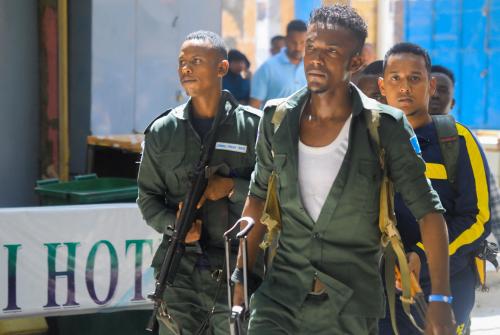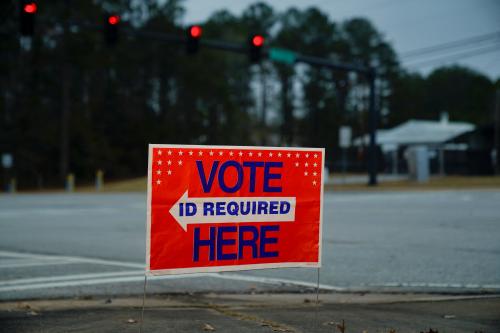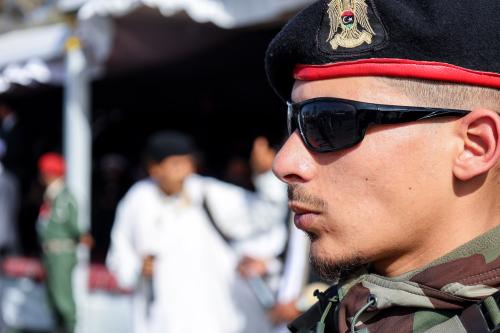Editor’s Note: The following article is the first in a series of reports based on Vanda Felbab-Brown’s fieldwork in Afghanistan in April 2012. Here she recounts her first-hand impressions of this week’s coordinated attacks in Kabul and their implications for the future of Afghan security.
Just to report that I’m alive but a bit bleary-eyed having spent most of the past 20 hours pinned down by the firefight and attacks in Kabul. Right now – about 1:45pm in Kabul – areas of the city are still under lockdown and security operations are still taking place. NATO and Afghan forces caught another attacker downtown still a few hours ago and continue to search for more.
Below are some details about what happened during the past 24 hours. I’m currently participating in a NATO-sponsored trip of opinion leaders from the United States, Europe, and Australia, who are all experts on Afghanistan and have been here many times. In a few days, the NATO-sponsored trip will be over, but I will stay in Afghanistan further and continue to travel and do research on my own.
My colleagues and I left the International Security Assistance Force (ISAF) headquarters Sunday morning on what started as a breezy, bright day. After meeting with some Afghan journalists, we were planning to visit the Peace Council, an institution established to support the Afghan government negotiations with the Taliban and other insurgents. Unfortunately, our meeting was canceled because of the the insurgent groups – a delegation from Gulbudin Hekmatyar’s Hezb-i-Islami arrived to meet with the Minister Advisor to the Afghan President on Home Security & Secretary-General to the High Peace Council of Afghanistan, Mohammed Stanekzai. (President Karzai’s office later announced that the delegation was also received at the Arg Palace.) Negotiations with Hekmatyar have been on and off for three years at least, and many politicians and powerbrokers associated with Hezb-i-Islami have positions of official and unofficial power in Afghanistan.
Our group then went to the Ministry of Mines to meet with the deputy minister, Mir Ahmad Javid, a very young impressive man determined to direct the ministry toward good governance and sustainable development. Under the leadership of Minister Wahidullah Shahrani and Mir Ahmad Javid, the Ministry is working hard to reform itself from once being a ministry known for a very corrupt deal selling one of Afghanistan’s major copper mines – Aynak — to a Chinese company to one of the most progressive and reformist ministries in Afghanistan. Following the 45-minute meeting at the Ministry of Mines, we were stopped by guards who said that attacks were underway in the area and that we should not leave the building.
We spent the next eight hours at the Ministry – one of the least likely buildings to be targeted by attacks in the Wazir Akbar Khan quarter of Kabul where ISAF headquarters, embassies, and many NGOs are located. Although we were only about 400 meters away from ISAF HQ, we could not move from the Ministry to ISAF HQ because the ISAF compound and in fact much of Wazir Akbar Khan went into immediate lockdown. No internationals and few Afghan civilians were moving on the streets. Technically, the locals were not supposed to be moving on the streets either, but many do not take the lockdown requirements seriously and are no longer fazed by attacks. Surprisingly, while RPG explosions and gunfire were taking place throughout the quarter and the nearby German, British, Russian embassies, the ISAF HQ, the Afghan Parliament, and the Kabul Star Hotel were under attack, some Afghan civilians continued digging ditches (which somewhat eerily resembled graves), selling their wares, and walking in the streets, seemingly inured to the attacks.
After six hours of attacks, most ministry officials left. Ministry guards eventually asked us to move out of the room we had been staying in, which was unfortunate since it had a TV broadcasting Al Jazeera’s coverage of the attacks going on around us in Kabul. Most of our blackberry batteries had since run down and our information became more limited.
Another hour later, we were out of water and dinner started to sound like a really good idea. We ate lunch earlier in the day, after persuading our Afghan drivers to stop at a kebab place. We were using regular cars, not military protected vehicles, which allowed us greater access to Afghan civilians and local markets. Lunch was a faint memory now. At that point, we tried to persuade the guards at the Ministry to allow our two Afghan drivers to leave the compound, go to a kebab place, and come back with food. Unfortunately, that request ended our stay at the Ministry of Mines since it brought us to the attention of the Afghan National Army unit commander just outside of the ministry’s gate. For the first time in eight hours, the ANA commander became aware that six VIP farangis (foreigners) were holed up in the ministry. That realized made the commander extremely displeased. First, he strongly berated the forlorn ministry guards, who were as unfazed by the attacks throughout the day as the Afghan civilians, for not informing him of our presence. Then he ordered us out of the compound.
That set off a round of back and forth calls with ISAF HQ. Our ISAF handlers were still under lockdown themselves. They did not want us to move and would not have allowed us to enter their compound anyway, even though it was just 400 meters away. However, the ANA commander insisted that we get out of the ministry building immediately. He wanted us off his hands and out of his responsibility. ISAF then considered allowing us to drive or walk to ISAF, but after the first checkpoint, we would still have to walk ways to our quarters. There could have been unexploded ordnance along the way since some RPG fire hit ISAF HQ. (Thankfully, no one was injured.) Perhaps the greatest security danger came from accidently provoking friendly fire from Afghan forces patrolling the streets as firefights were still going on, major buildings were under attacks, and rumors of more suicide bombers moving on around the city were going on.
Over the course of the past several hours, I had suggested that we move to Serena Hotel, one of the luxury hotels in Kabul, also only 400 meters from the Ministry of Mines and in the opposite direction of ISAF HQ. Since it had been a popular Taliban target in the past (in 2008, the Taliban attacked the hotel and killed six people and injured another six), but NATO preferred that we did made no movements on the streets. However, now that the ANA kicked us out of the Ministry of Mines, ISAF security had no choice but to agree to our move to the Serena. So we jumped into our two cars and made a mad dash for the Serena Hotel. Although we only had to travel a very short distance, we managed to come within a few inches of a collision with another civilian vehicle, which apparently was moving unhindered and at high speed down the street.
When we arrived at the front gates of the Serena Hotel, the Afghan National Police (ANP) officers at the checkpoint became extremely agitated pointing their machine guns on us – understandably given that our two cars arrived during the middle of a siege and could have believed that a suicide bomber was in the car. We rolled down the car windows and started waving and telling them we were Westerners and that they should not shoot. After a few tense moments, all was resolved and we got safely into Serena.
In a somewhat surreal moment given that firefights were going on around, we spent a good amount of time negotiating with the receptionist over where we could get NATO’s rate for Serena’s pricey rooms. After a rather opulent dinner – given the circumstances of the firefight and Afghan poverty – we checked into our rooms. As luck would have it, I wound up alone in a junior suite in a distant wing of the hotel, far from the rest of my party. While treated to a junior suite, I also ended up on the side of the hotel closest to major firefights, explosions, armored truck movements, and chopper flyways – all just outside my windows. The action kicked off between the witching hour and the wee hours of the morning and lasted until about 6:30am, guaranteeing I would not get one minute of sleep. Moreover, in the first hour of the firefight, the gunfire was so close that it was not clear whether Serena itself was under attack.
Given the particulars of my accommodations, I decided to lie in bed fully dressed, just in case a quick getaway was needed. I watched Al Jazeera’s coverage of the war in Sudan and the environmental problems in Australia and listened to the firefights taking place outside my windows. At 8am, I met up with my colleagues for breakfast. All of them were outrageously bright-eyed and well-rested, having slept through the night and having not heard one single gunshot.
Lessons learned? Always carry a spare cell phone battery in your emergency grab bag. Always carry the emergency grab bag with you – it really isn’t that useful if you don’t have the emergency bag with you during an emergency. And finally, always ask the hotel receptionist if your room is on the side of the hotel facing the gunfire.
Serious analysis of the event: The attacks were spectacular in their level of coordination and the sheer number of attacks carried out in Kabul and across Afghanistan. There was also a very obvious and serious intelligence failure. President Karzai has blamed the intelligence failure on ISAF, but the Afghan security agencies need to look deeply into themselves instead of engaging in finger pointing and fighting among the National Directory of Security, the Ministry of Defense, and the Ministry of Interior.
Equally spectacular and surprising was the very small number of civilian casualties. The attacks will likely be seen as more effective in having a psychological impact – which of course is the game of the insurgents – than in causing much physical disruption or many casualties. Given that the number of civilian casualties was so low, one has to wonder whether that outcome was on purpose. Possibly the attackers were following instructions from Mullah Omar to keep the Afghan civilian casualties low. Was it, in fact, the Quetta Shura who carried out the attacks imitating the Haqqanis? Or did the Haqqanis themselves conduct the attacks — the modus operandi indicates the Haqqanis, Kabul is where the Haqqanis tend to strike. However, the Haqqanis are often motivated to cause many more casualties. Certainly it would not have been terribly difficult to achieve a far greater level of casualties than turned out to be the case.
The ANSF, particularly the special commando forces of the Afghan National Police, seemed to perform well (our experience with the ANA commander notwithstanding). Certainly, they performed much better than during the attacks on the Intercontinental Hotel in June 2011, when NATO helicopters played a far more important role in ending the siege than during the current attack. The ANP forces were also able to maintain better personal security and did not charge headlong into fire and certain death, and they were able to maintain better command and control throughout. Did they perform better than during the attack on the US Embassy in September 2011? That is much harder to say, but the full verdict on the quality of the ANSF performance is still out.
The ANSF is clearly making progress, but it still continues to be dependent on ISAF support in many critical areas, such as air support, intelligence, command and control, medi-vac, and other specialty enablers. Moreover, much yet needs to improve in reducing ethnic and patronage factionalization within the ANA and similar patronage and generalized corruption within the ANP in order for the Afghan security forces not to splinter after the 2014 reduction in foreign troop presence and the much more severe secure and legitimacy pressures the institutions will then face.



Commentary
Op-edAfghanistan Field Trip Report I: Firefight in Kabul
April 19, 2012